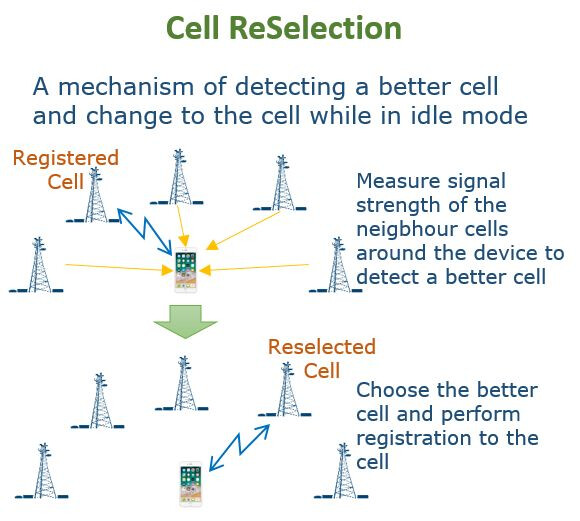Cell reselection is a critical process in mobile networks, enabling User Equipment (UE) to maintain optimal connectivity while in idle mode. This process ensures that the UE remains connected to the most suitable cell, enhancing service quality and user experience.
4G LTE Cell Reselection
In 4G LTE, cell reselection occurs when the UE is in RRC_IDLE mode. The UE periodically measures the Reference Signal Received Power (RSRP) and Reference Signal Received Quality (RSRQ) of its serving cell and neighboring cells. If a neighboring cell offers better signal strength or quality, the UE may initiate a reselection. The decision is based on several criteria:
-
Signal Strength and Quality:
The neighboring cell must have a higher RSRP and RSRQ than the current serving cell. -
Hysteresis (Qhyst):
A margin is applied to prevent frequent reselections due to minor fluctuations in signal strength. -
Time-to-Trigger (Treselection):
The neighboring cell’s signal must be better for a specified duration before reselection occurs. -
Cell Offsets (Qoffset): These parameters control the difficulty of reselection to neighboring cells, influencing the UE’s decision to switch cells.
These parameters are broadcasted in System Information Blocks (SIBs), allowing the UE to make informed decisions about cell reselection.
5G NR Cell Reselection
In 5G New Radio (NR), cell reselection is more complex due to the introduction of new frequency bands and the coexistence of multiple Radio Access Technologies (RATs). The UE evaluates neighboring cells based on a similar set of criteria as in 4G, with additional considerations for inter-frequency and inter-RAT reselection.
-
Intra-Frequency Reselection:
The UE compares cells within the same frequency band, using parameters like RSRP, RSRQ, Qhyst, and Treselection. -
Inter-Frequency Reselection:
When considering cells in different frequency bands, the UE applies cell offsets (Qoffset) to manage reselection thresholds. -
Inter-RAT Reselection: For transitions between different RATs, such as from LTE to 5G NR, the UE assesses the suitability of the target RAT based on signal quality and priority settings.
Additionally, in 5G NR Standalone (SA) mode, LTE cells may broadcast information about NR cells (via SIB24), enabling UEs to reselect to 5G NR cells when conditions are favorable.
Summary
Cell reselection is a dynamic process that allows UEs to maintain optimal connectivity by selecting the best available cell. While the fundamental principles remain consistent across 4G and 5G, the complexity increases in 5G due to the broader spectrum of frequency bands and the coexistence of multiple RATs. Understanding these processes is crucial for network optimization and ensuring seamless user experiences in modern mobile networks.
LinkedIn: ![]()
